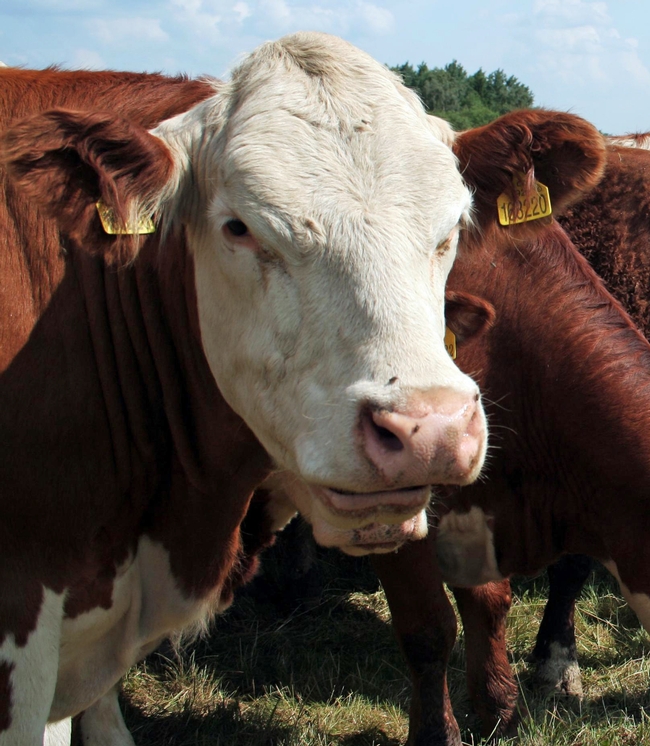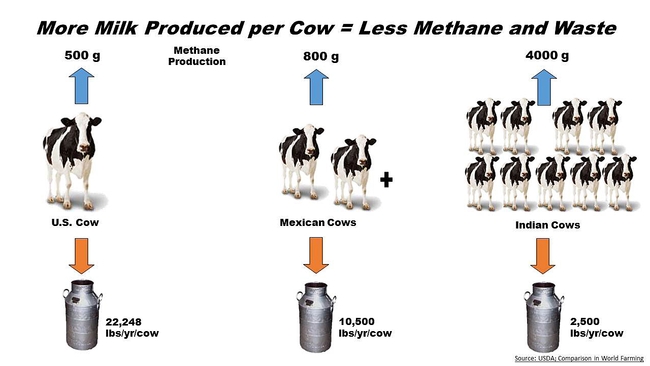Frank Mitloehner, Professor & Air Quality Specialist
Department of Animal Science, University of California, Davis
As the November 2015 Global Climate Change Conference COP21 concluded in Paris, 196 countries reached agreement on the reduction of fossil fuel use and emissions in the production and consumption of energy, even to the extent of potentially phasing out fossil fuels entirely. Both globally and in the U.S., energy production and use, as well as the transportation sectors, are the largest anthropogenic contributors of greenhouse gasses (GHG), which are believed to drive climate change. While there is scientific consensus regarding the relative importance of fossil fuel use, anti-animal agriculture advocates, portray the idea that livestock is to blame for a lion's share of the contributions to total GHG emissions.
One argument often made is U.S. livestock GHG emissions from cows, pigs, sheep and chickens are comparable to all transportation sectors from sources such as cars, trucks, planes, trains, etc. The argument suggests the solution of limiting meat consumption, starting with “Meatless Mondays,” will show a significant impact on total emissions.
When divorcing political fiction from scientific facts around the quantification of GHG from all sectors of society, one finds a different picture. Leading scientists throughout the U.S., as well as the U.S. Environmental Protection Agency (EPA) have quantified the impacts of livestock production in the U.S., which accounts for 4.2% of all GHG emissions, very far from the 18% to 51% range that advocates often cite. Comparing the 4.2% GHG contribution from livestock to the 27% from the transportation sector, or 31% from the energy sector in the U.S.brings all contributions to GHG into perspective. Rightfully so, the attention at COP21 was focused on the combined sectors consuming fossil fuels as they contribute more than half of all GHG in the U.S.
Breaking down the 4.2% EPA figure for livestock by animal species, shows the following contributors: beef cattle 2.2%, dairy cattle 1.37%, swine 0.47%, poultry 0.08%, sheep 0.03%, goats 0.01% and other (horses, etc.) 0.04%. It is sometimes difficult to put these percentages in perspective, however; if all U.S. Americans practiced Meatless Mondays, we would reduce the U.S. national GHG emissions by 0.6%. A beefless Monday per week would cut total emissions by 0.3% annually. One certainly cannot neglect emissions from the livestock sector but to compare them to the main emission sources would put us on a wrong path to solutions, namely to significantly reduce our anthropogenic carbon footprint to reduce climate change.
In spite of the relatively low contributions to total GHG emissions, the U.S. livestock sector has shown considerable progress during the last six plus decades, and commitment into the future, to continually reduce its environmental footprint, while providing food security at home and abroad. These environmental advances have been the result of continued research and advances in animal genetics, precision nutrition, as well as animal care and health.
| 1950 | 2015 | |
| Total Dairy Cows: | 22 million dairy cows | 9 million dairy cows (-59%) |
| Milk Production: | 117 billion pounds | 209 billion pounds (+79%) |
| Carbon Footprint: | 1/3 that of 1950 | |
| 1970 | 2015 | |
| Total Beef Cattle: | 140 million head | 90 million head |
| Beef Production: | 24 billion pounds | 24 billion pounds (-36%) |
Globally, the U.S. livestock sector is the country with the relatively lowest carbon footprint per unit of livestock product produced (i.e. meat, milk, or egg). The reason for this achievement largely lies in the production efficiencies of these commodities, whereby fewer animals are needed to produce a given quantity of animal protein food, as the following milk production example demonstrates: the average dairy cow in the U.S. produces 22,248 lbs. milk/cow/year. In comparison, the average dairy cow in Mexico produces 10,500 lbs. milk/cow/year, thus it requires 2-plus cows in Mexico to produce the same amount of milk as one cow in the U.S. India's average milk production per cow is 2,500 lbs. milk/cow/year, increasing the methane and manure production by a factor of 9 times compared to the U.S. cow. As a result, the GHG production for that same amount of milk is much lower for the U.S. versus the Mexican or Indian cow. Production efficiency is a critical factor in sustainable animal protein production and it varies drastically by region.
Improvements in livestock production efficiencies are directly related to reductions of the environmental impact. Production efficiencies and GHG emissions are inversely related—when the one rises, the other falls.
The 2050 challenge to feeding the globe is real: throughout our lifetime, the global human population will have tripled from three to more than nine billion people without concurrent increases of natural resources to produce more food. Our natural resources of land, water and minerals (fertilizer) necessary for agricultural production, have not grown but in fact decreased. As a result, agriculture will have to become much more efficient worldwide and engage in an efficient path similar to the one it has traveled down in U.S. livestock production in recent decades.
How can emissions accurately and fairly be assessed to lay ground for a path for solutions?
In its quest to identify a sustainable, scientific path toward fulfilling the future global food demand, the Food and Agriculture Organization of the United Nations (FAO) has formed an international partnership project to develop and adopt a “gold standard” life cycle assessment (LCA) methodology for each livestock specie and the feed sector. The ‘Livestock Environmental Assessment and Performance Partnership' (LEAP), engaged with more than 300 scientists from the world's most prestigious academic institutions in developing this unprecedented effort in developing a global benchmarking methodology. The first three-year phase project was finalized in December 2015 with six publicly available LCA guidelines. This globally harmonized quantification methodology will not only allow the accurate measurement by livestock species and production regions across the globe today, but will also identify opportunities for improvement and the ability to measure that progress in each region going forward.
Summary
Addressing the 2050 challenge of supplying food to a drastically growing human population can sustainably be achieved through intensification of livestock production. Indeed, intensification provides large opportunities for climate change mitigation and can reduce associated land use changes such as deforestation. Production efficiencies reduce environmental pollution per unit of product.

The livestock sector is committed to continuous improvement of their environmental impact in North America, and to doing its part in transferring knowledge, technologies and best practices to enhance global environmental livestock impact by region. Now is the time to end the rhetoric and separate facts from fiction around the numerous sectors that contribute emissions and to identify solutions for the global food supply that allow us to reduce our impact on the planet and its resources.
Last updated 06-28-16


